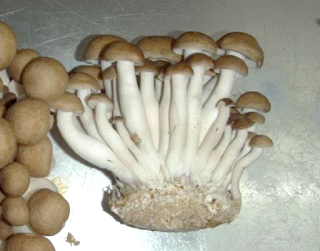[This entry is taken from a chapter of Part II of the open-source textbook Spanish-English Cognates: An Unconventional Introduction to Spanish Linguistics.]
[Go to Part 1 of Words for Mushrooms and Other Fungi]
Chanterelle mushroom
One of the most popular and abundant wild mushrooms to eat
are the chanterelle mushrooms of which there are many species and varieties. They
are found in in Eurasia, North and Central America and Africa. They go by the
generic name chanterelle (mushroom) in English, pronounced [ˈʧæntəɹɛɫ] or [ˌʃɒntəˈɹɛɫ].[i]
In Spanish, this type of mushroom is known primarily as rebozuelo, but
also as anacate or chantarela.[ii]
Mushroom hunters must be careful since there are poisonous look-alikes, such as
the jack-o’-lantern mushroom (Omphalotus olearius). Originally, all the known
chanterelles were all assigned to the genus Cantharellus but they are
now seen as species from at least four different genera that happen to share
external similarities: Cantharellus, Craterellus, Gomphus,
and Polyozellus.
Perhaps the most common or well-known type of chanterelle
are the highly-prized yellow chanterelle or golden chanterelle,
whose botanical name is Cantharellus cibarius. Another common name for
this mushroom is girolle or girole, pronounced [ʤəˈɹoʊ̯ɫ],
which is a late 19th century loan from French, which was first attested in 1513
in Middle French and which may come ultimately from classical Lat. gyrus
‘circle, circuit, career’, alluding ‘to the shape of its cap’ to which a
diminutive suffix was added (‑olle/‑ole) (OED).
There are at least eight other species of the genus Cantharellus
that are considered to be chanterelle mushrooms besides Cantharellus
cibarius: Cantharellus cascadensis (Cascade chanterelle), Cantharellus
cinnabarinus (cinnabar red chanterelle), Cantharellus formosus (Pacific
golden chanterelle), Cantharellus lateritius (smooth chanterelle),
Cantharellus subalbidus (white chanterelle), Cantharellus
enelensis (discovered in 2017), Cantharellus minor, Cantharellus
roseocanus (a distinct species since 2012).
At least five species of the Craterellus genus are also
known as chanterelles. One of the better known ones is the black trumpet
mushroom, also known as horn of plenty, black chanterelle, or
trumpet of the dead. Two related species are lumped together under the
name black trumpet: Craterellus cornucopioides in Europe and Craterellus
fallax in Eastern North America. Its most common Spanish names are trompeta
de los muertos ‘trumpet of the dead’, cuerno de la abundancia ‘horn
of plenty’, and trufa del pobre ‘poor man’s truffle’.[iv]
As you can see in Figure 13,
there is no clear separation between the stem and the cap of this mushroom.
Rather, the mushroom is shaped as a funnel or like a trumpet. It is found in
woods in Europe, North America, and East Asia, mostly in moist areas in the
shade under under beech and oak trees.
Another chanterelle from the genus Craterellus is the
funnel chanterelle, also known as yellowfoot or winter mushroom,
whose botanical name is Craterellus tubaeformis, formerly known as Cantharellus
tubaeformis, since it was thought to belong to the Cantharellus genus.[vi]
Finally there are at least two more species whose name may
contain the word chanterelle, from yet two different genera. One is the violet
chanterelle, also known as pig’s ears, whose botanical name is Gomphus
clavatus. The other one is blue chanterelle, or, in Alaska, black
chanterelle, whose botanical name is Polyozellus multiplex.
The genus name Cantharellus is a New Latin word derived
from Lat. canthărus
‘a large, wide-bellied drinking-vessel with handles, a tankard, pot’ by means
of the Latin diminutive suffix ‑ell‑us. Lat. canthărus is a loanword from
Ancient Greek κάνθαρος (kántharos)
‘drinking cup or vessel, chalice’ and the source of Sp. cántaro for a large
usually clay vessel, with a narrow mouth, wide belly, and narrow foot, usually
with one or two handles. Note that English has borrowed cantharus or kantharos
to refer to ‘a large, two-handled drinking-cup’ of classical times (OED). The
name chanterelle is the French version of the New Latin name, first
attested with this sense in 1752, though there are other, unrelated, earlier words
chanterelle in French related to the word chant ‘song, etc.’ and
chanter ‘to sing’ (cf. Sp, canto, cantar). The Spanish analog
would be cantarito ‘small cántaro’, which happens to be the name of a Mexican
cocktail made with tequila and fresh citrus juice and typically served in a clay
glass.
[ii] Cf. https://en.wikipedia.org/wiki/Cantharellus_cibarius,
https://es.wikipedia.org/wiki/Cantharellus_cibarius
[iii] Source: De Andreas Kunze
- Trabajo propio, CC BY-SA 3.0, https://commons.wikimedia.org/w/index.php?curid=12685420
(2022.01.22)
[iv] Cf. https://en.wikipedia.org/wiki/Craterellus_cornucopioides,
https://es.wikipedia.org/wiki/Craterellus_cornucopioides,
https://www.fichasmicologicas.com/?micos=1&s=Craterellus%20cornucopioides&art=300
[v] Source: https://commons.wikimedia.org/wiki/File:Craterellus_cornucopioides_6.jpg
(2022.01.22)
[vi] Cf. https://en.wikipedia.org/wiki/Craterellus_tubaeformis,
https://es.wikipedia.org/wiki/Craterellus_tubaeformis
[vii] Source: By Jörg Hempel,
CC BY-SA 3.0 de, https://commons.wikimedia.org/w/index.php?curid=35949525
(2022.04.12)
[viii] Source: Cántaro of
Anguita (Guadalajara, Spain). Natacha Seseña Legacy Fund, 10 May 2012, Own
Work, Milartino, https://commons.wikimedia.org/wiki/File:C%C3%A1ntaro_Anguita,_Guadalajara_Spain.JPG
(2022.04.12)













.jpg)
